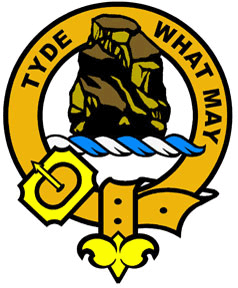Haig Clan
Haig Clan Crest: A rock, Proper.
Haig Clan Motto: Tyde What May (Come what may).
Haig Clan History: THE Haigs are first noted in Scotland in the 12th century when Petrus de Haga witnessed the sale of two serfs, along with their sons and daughters and all their progeny. He also witnessed a charter from Richard de Morville, Constable of Scotland, to the Monastery of Dryburgh, when he is also identified as the owner of the lands of Bemersyde. It has been suggested that the family is of Pictish origin, but de Haga's appearance in De Morville's Charter strongly suggests a Norman provenance.
In the thirteenth century, the poet Thomas the Rhymer, Laird of Ercildoune, made the prediction that:
“Tyde what may
Whate're betide
Haig shall be Haig
of Bemersyde.”
As a significant Scottish Borders family, it was inevitable that the Haigs were caught up in the political and religious conflicts of Scotland throughout the centuries. In 1242, one of the family was sent by Alexander II to capture John de Bisset following the murder of the Earl of Athol. In 1296, the 5th Laird of Bemersyde swore allegiance to Edward I of England but thereafter fiercely supported the cause of Scottish Independence, fighting for Sir William Wallace at the Battle of Stirling Bridge in 1297. Peter Haig, the teenage 6th Laird of Bemersyde, fought for Robert the Bruce at the Battle of Bannockburn in 1314. He was later slain at the Battle of Halidon Hill in 1333. Gilbert Haig, 11th Laird of Bemersyde, was one of the leaders of the Scots army who defeated the English at the Battle of Sark in 1449. William Haig, 13th Laird of Bemersyde, was killed at Flodden in 1513. His son, James, the 14th Laird of Bemersyde, gained revenge for his father’s death, at the battle of Ancrum Moor in 1544, when he captured the notorious English commander, Sir Ralph Eure, who died of his wounds some days later at Bemersyde.
William Haig, the 18th Laird, was made the kings Solicitor and Collector of the Burgh Taxes in Scotland in 1626. In 1633 he was banished and forfeit for treason. The 21st Laird, Anthony Haig, was imprisoned for aligning himself with the Quaker movement.
Douglas Haig (1861-1928), born in Edinburgh into the famous Haig Whisky distilling family. He became the single most controversial general in British history, as Commander in chief of the British Expeditionary Force in France. He eventually led his forces to victory, after a long and horrendous war of attrition, on the Western Front. He was made Earl Haig in 1919. Bemersyde was purchased by public subscription in 1921 and presented to Earl Haig, a descendant of the second son of the 17th Laird of Bemersyde.
George Alexander Eugene Douglas "Dawyck" Haig (1918–2009), the second Earl, served in WW2 with the Royal Scots Greys as a second lieutenant and was captured in North Africa. He spent time in several Italian prisoner of war camps, before being sent to Colditz Castle, in Germany, where he was selected as a member of the prominenti, a group of prized hostage prisoners who were heavily guarded because of their influential links. He became a fine modern painter after the war, and in 1958, was appointed to the Royal Fine Art Commission for Scotland, by the Queen. He was awarded the OBE in 1966.
General Alexander Haig (1924-2010) was the White House chief of staff under Richard Nixon, supreme commander of NATO, and US Secretary of State under Ronald Reagan.
Surname distribution in Scotland: The highest concentration of Haigs can be found in the Scottish Borders and Fife.
Places of interest:
Bemersyde House, St Boswells, Scottish Borders. Bemersyde has been held by the Haig family since known memory. The original 16th century building is a six storey Border peel-tower with walls which
are some 10ft thick in places. A mansion was added to both sides of the tower in the latter half of the 18th century. The house is the private home of the third Earl Haig and his family. However, the gardens, which
were created by the first Earl, are occasionally open to the public.
In addition to the main family home at Bemersyde, the Haig family, at various periods in their long history, held estates and fortified tower houses, at Brotherstone, Melrose, Borders. Hazeldean, Lauder, Borders. Ramornie,
Ladybank, Fife. Third, St Boswells, Borders and Whitrig, St Boswells, Borders.
Haig Clan membership certificates.

